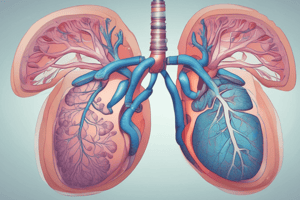Podcast
Questions and Answers
What do these tests determine about the air?
What do these tests determine about the air?
- The speed of air movement
- The amount of air that your lungs can hold (correct)
- The air pressure in the lungs
- The amount of oxygen in the air
What is the purpose of these tests in relation to the lungs?
What is the purpose of these tests in relation to the lungs?
- To remove carbon dioxide from the lungs
- To measure the lungs' ability to take in oxygen and remove carbon dioxide (correct)
- To slow down air movement in the lungs
- To add oxygen to the lungs
What can these tests diagnose?
What can these tests diagnose?
- Only COPD
- Only Pulmonary fibrosis
- Only Asthma
- Lung diseases, including Asthma, COPD, and Pulmonary fibrosis (correct)
What is measured by these tests in relation to the blood?
What is measured by these tests in relation to the blood?
What can be measured by these tests in terms of lung problems?
What can be measured by these tests in terms of lung problems?
What is the primary purpose of lung function tests?
What is the primary purpose of lung function tests?
What is another name for lung function tests?
What is another name for lung function tests?
What do lung function tests evaluate?
What do lung function tests evaluate?
What is the abbreviation for lung function tests?
What is the abbreviation for lung function tests?
What is the focus of lung function tests?
What is the focus of lung function tests?
What is the residual volume of the lungs?
What is the residual volume of the lungs?
What is the approximate volume of air remaining in the lungs after the most forceful expiration?
What is the approximate volume of air remaining in the lungs after the most forceful expiration?
What happens to the air in the lungs during the most forceful expiration?
What happens to the air in the lungs during the most forceful expiration?
What is the significance of the residual volume?
What is the significance of the residual volume?
What is the tidal volume (TV) in terms of breathing?
What is the tidal volume (TV) in terms of breathing?
What is the term for the process of exhaling as much air as possible from the lungs?
What is the term for the process of exhaling as much air as possible from the lungs?
What is the approximate volume of the tidal volume in an average young adult man?
What is the approximate volume of the tidal volume in an average young adult man?
What is the tidal volume measured from?
What is the tidal volume measured from?
What can be inferred about the tidal volume in an average young adult woman?
What can be inferred about the tidal volume in an average young adult woman?
What can be said about the tidal volume in different individuals?
What can be said about the tidal volume in different individuals?
What is the total amount of air that can be expelled from the lungs after filling them to their maximum extent?
What is the total amount of air that can be expelled from the lungs after filling them to their maximum extent?
What is the sum of IRV, TV, and ERV?
What is the sum of IRV, TV, and ERV?
What happens to the lungs before measuring vital capacity?
What happens to the lungs before measuring vital capacity?
What is the maximum extent of expiration after filling the lungs?
What is the maximum extent of expiration after filling the lungs?
What is the sequence of events in measuring vital capacity?
What is the sequence of events in measuring vital capacity?
Flashcards are hidden until you start studying
Study Notes
Lung Function Tests
- Evaluate how well the lungs work, including the volume of air they can hold and the speed of air movement.
- Determine the amount of air the lungs can hold and the ability to add oxygen and remove carbon dioxide from the blood.
Lung Function Test Indications
- Diagnose lung diseases, such as Asthma, COPD, and Pulmonary fibrosis.
- Measure the severity of lung problems.
Lung Volumes
Tidal Volume (TV)
- The volume of air inspired or expired with each normal breath.
- Approximately 500 ml in an average young adult man.
Residual Volume (RV)
- The volume of air remaining in the lungs after the most forceful expiration.
- Approximately 1100-1200 ml.
Vital Capacity (VC)
- The maximum amount of air that can be expelled from the lungs.
- Calculated by: IRV (Inspiration Reserve Volume) + TV + ERV (Expiration Reserve Volume) = 3000 + 500 + 1100 = 4600 ml.
- Represents the maximum amount of air that can be exhaled after filling the lungs to their maximum extent and then expiring to the maximum extent.
Studying That Suits You
Use AI to generate personalized quizzes and flashcards to suit your learning preferences.



